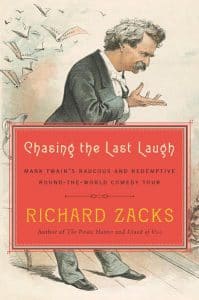Mark Twain on Crisis Communication
Mark Twain was the most famous man of his time, his unforgettable image known around the world. He carefully cultivated his image or, as we might say today, built his brand.
In Chasing the Last Laugh: Mark Twain’s Raucous and Redemptive Round-the-World Comedy Tour, Richard Zacks tells how the author of Tom Sawyer and Huckleberry Finn went bankrupt in a very public way. He also managed to pay back his debts and endear himself all over again to his fans. To be sure, he was a master of crisis communication.
Q Twain, you suggest, was a master of brand building. How so?
He was very ambitious. He had unbelievable energy. He was capable of writing 10,000 words a day but also wasted huge amounts of time traveling, entertaining and inventing things. He also wasted a lot of money. But all the while, he was cultivating his image, and when it needed to be repaired, he was smart in making sure it got repaired.
Q So he knew how to handle crisis communication?
He did. Twain always wanted to be like a Rockefeller or a Vanderbilt. He was never content to be a writer, much less a comic writer. He wanted to be taken seriously, and his wife, Olivia Langdon, encouraged him to pursue respectability. Livy, as he called her, was an heiress. And while he truly adored her, she also was a smart match financially. Her father died in the first year of their marriage, leaving her a fortune. But Twain burned through the money in a hurry, building a mansion in Hartford, Conn., and making a series of bad investments, which did present a crisis.
Q What bad investments?
The worst of these investments was the Paige Compositor, a complicated machine for setting type for newspapers. He thought it would become the industry standard in the newspaper business, but it never worked as intended and was eventually rendered obsolete. He was the main investor in that machine for years, and by the time Twain was 59, he owed $60,000 to banks and business partners. That’s about $1.8 million today.
Q What did he do?
The man who helped him out of his bankruptcy was H.H. Rogers, a Standard Oil executive. Rogers, who was one of the richest men America ever produced, helped negotiate new contracts for Twain’s books and transferred the copyrights to Twain’s wife. Rogers also encouraged Twain to make the “round-the-world” lecture tour in 1895 that’s the subject of my book. Twain used the profits from his lectures to pay back his debts.
 Q He spun that brilliantly, right?
Q He spun that brilliantly, right?
Yes, he did. Twain was legally obligated to pay back 100 percent of the money he owed the different companies, banks and other creditors. But that’s not what he told the newspapers that were covering his money problems. Twain told reporters that he was obligated to pay only 50 cents on the dollar. But because he was a man of honor, he was going to pay back every nickel. The public loved it. People went from disapproving of his extravagance to believing he was a great man after all. Suddenly, he was this beloved figure once again.
Q But that wasn’t the only thing he did to patch up his image, was it?
Not at all. At one point, a New York City newspaper learned of his financial problems and started a charity drive on his behalf, encouraging his fans to send their donations. Twain was very vocal about how embarrassed he was about this and how he couldn’t in good conscience accept charity. Admirable, but untrue. Rogers told Twain that any such effort by the paper would be a stain on his reputation. But it was worse than that because people weren’t donating to the cause. This made it even more embarrassing. As a joke, the paper printed the names of dead people, saying they were contributing. That really was embarrassing. But at that point, Twain made an ingenious suggestion.
“He was legally obligated to pay back 100 percent of the money he owed. But that’s not what he told the newspapers.”
Q Which was what?
Twain asked Rogers to make a big contribution to the fund — $40,000 — but to do so anonymously so people would think the charity drive was a big success. Twain was to receive this “anonymous” contribution, which he would then surreptitiously return to Rogers. This was a clever PR move on Twain’s part, but Rogers thought it was a terrible idea and didn’t even respond to the suggestion.
Q Eventually, after Twain followed Rogers’ advice and paid his debts, his books continued to sell well and he died a wealthy man, right?
He was 74 when he died in 1910 and left an estate of almost $500,000 — $15 million today — which is impressive, considering all the ups and downs.
Q What can we learn from this?
First, never put all your eggs in one investment — in Twain’s case, the Paige Compositor. Second, keep your sense of humor about yourself, which Twain seemed to do. Finally, shape your own narrative. He was a genius at that.
Reach Zacks at [email protected] or 646.226.0350.



